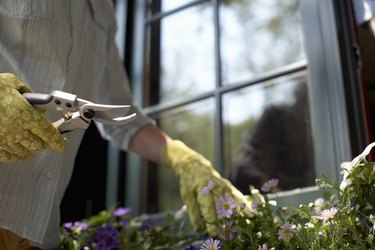Powdery mildew is a disease that commonly affects plant tissue. The various strains of powdery mildew all have similar characteristics, including producing patches of white to gray, powdery growth. This growth primarily appears on the tops of leaves, but occasionally shows up on the undersides of leaves as well as on buds, flowers, immature fruit and stems. Promptly recognizing and treating powdery mildew infections can prevent any serious damage to your plants.

Video of the Day
Things You'll Need
Bleach
1 Gallon Water
Pruning Tools
Garden Pump Sprayer
1/2 Tsp. Mild Liquid Soap
Plant-Based Fungicide
Biological Fungicide
1 Tbsp. Baking Soda
Step 1
Make a nontoxic solution to treat mild powdery mildew. Combine 1/2 tsp. of mild liquid soap, 1 tbsp. of baking soda and 1 gallon of room-temperature water in a small garden pump sprayer. Thoroughly spray your infected plants, taking care to spray the undersides of the leaves. Treat your plants once a day for three consecutive days. Make a new batch of the solution each time you spray.
Video of the Day
Step 2
Use a plant-based fungicide on mild to moderate powdery mildew infections. The University of California's Integrated Pest Management Program suggests using fungicides that contain neem oil or jojoba oil. These low-toxicity fungicides eradicate existing powdery mildew infections and protect your plants from new infections. Spray the fungicide over your entire plant as soon as you notice the mildew.
Step 3
Apply biological fungicides for moderate powdery mildew infections. These commercial fungicides contain microorganisms that destroy the fungal pathogens infecting the plant tissue. Follow the manufacturer's directions on the label when using biological fungicides.
Step 4
Prune out plants with severe powdery mildew infections. Throw away or burn the diseased plant tissue. Immediately disinfect any pruning tools with a solution of one part bleach to four parts water.
Step 5
Prevent powdery mildew infections. The best way to control powdery mildew is to keep the fungal pathogens from becoming established. Buy only disease-resistant cultivars and plant them in well-drained soils that receive full sun. Ensure your plants have adequate air circulation and avoid overhead irrigation methods and sprinklers.
Tip
Leave enough space when planting seeds or seedlings to promote good air circulation. Selectively prune out dense plant material to provide adequate airflow, but don't overprune your plants because new shoots are more susceptible to powdery mildew infections.
Warning
Make sure the liquid soap you use in the nontoxic solution doesn't contain any lotions.
Always pretest any treatment on a few inconspicuous leaves to make sure that your plant isn't sensitive to the solution.